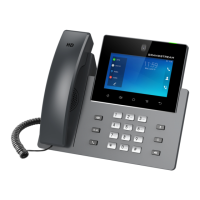GXV3350 Administration Guide
Version 1.0.3.27
Allow DHCP Option 242
(Avaya IP Phones)
Enables DHCP Option 242. Once enabled, the phone will use the
configuration info issued by the local DHCP in Option 242 to configure
proxy, transport protocol and server path. The default setting is “Yes”.
Download and Process
All Available Config
Files
By default, the device will provision the first available config in the order of
cfgMAC, cfgMAC.xml, cfgMODEL.xml, and cfg.xml (corresponding to
device specific, model specific, and global configs). If set to "Yes", the
device will download and apply (override) all available configs in the order
of cfgMAC, cfg.xml, cfgMODEL.xml, cfgMAC.xml. Default Setting is “No”.
Device will download the configuration files and provision by the configured
order.
Enables the PNP (Plug and Play) feature on the device. If it is enabled, the
device will be set as a provision server to send SIP NOTIFY message
including the provision URL to response the client phone’s SIP
SUBSCRIBE request.
This feature will be enabled if the PNP URL is configured. If this setting is
enabled, the 3CX Auto provision will be disabled automatically.
Configures the URL to provision another client phone’s config server path.
The URL will be included in the SIP NOTIFY message.
Sets the phone system to broadcast the SIP SUBSCRIBE message during
booting up to allow itself to be discovered and be configured by the SIP
platform. The default setting is "Yes".
Enable SIP NOTIFY
Authentication
Enables the phone to challenge SIP NOTIFY with 401.
The default setting is “Yes”.
Validate Certification
Chain
Configures whether to validate the server certificate when download the
firmware/config file. If it is set to "Yes", the phone will download the
firmware/config file only from the legitimate server. Default setting is "No".
Enable/disable EEE mode. If set to "Yes", the phone will turn on the EEE
mode. Note: Regardless of whether the EEE mode is turned on or off, the
network will reconnect.
Sets the phone system to broadcast the Multicast DNS (mDNS) message
during booting up to allow itself to be discovered and be configured by the
SIP platform. If it is set to “User Type A’, the phone system will broadcast
the MDNS message “A_grandstream-cfg.local”; if it is set to “Use Type
SRV”, the MDNS message will be “SRV_grandstream-cfg.local”.
The default setting is “Use Type A”.
Resets the phone system to the default factory setting mode.

